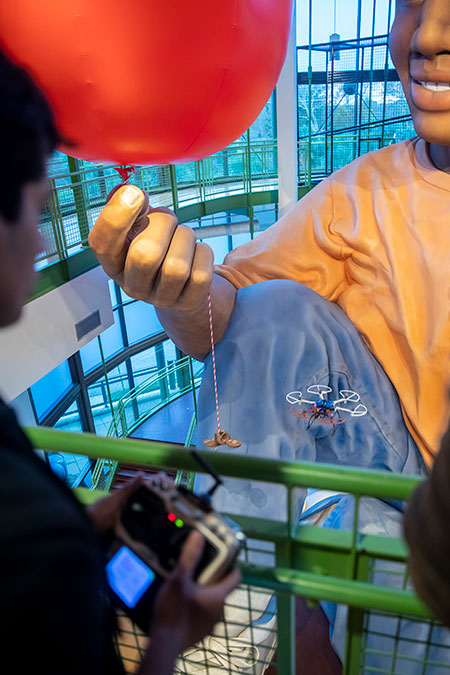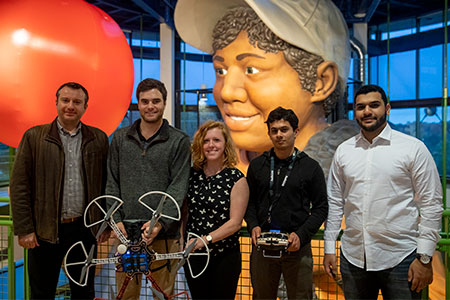A major dustup
Engineering students design robotic drone to clean ‘world’s largest boy’
Posted on: December 11, 2018; Updated on: December 11, 2018
By Chris Horn, chorn@mailbox.sc.edu, 803-777-3687
He’s been called the world’s largest boy, and, like most boys, Eddie has tended to get dirty. But the 40-foot-tall statue at Columbia’s EdVenture children’s museum won’t be collecting dust bunnies anymore, thanks to mechanical engineering students at the University of South Carolina who have designed a robotic cleaning drone.
The students successfully tested the drone at the end of November, piloting the hexacopter over Eddie’s massive torso and giant ballcap as the rotors’ down blast and extra blower dispatched countless dust bunnies to the floor.

The downblast from the drone's six rotors and a horizontal facing blower whisk dust from Eddie's massive body.
“Did you see all the dust coming off his cap?” exclaimed Ayoub Alwahaibi, one of the four students completing the senior capstone design project in the College of Engineering and Computing. The College of Engineering and Computing’s senior capstone design program is a graduation requirement for all of the college’s students, serving as both professional development and workforce readiness for 21stcentury careers.
EdVenture personnel had previously consulted with the college’s McNAIR Center for Aerospace Innovation and Research on a NASA-funded children’s exhibit on flight. That prompted the museum to approach the college about tackling Eddie’s dust problem with the idea that a dust-blowing drone could also serve as a dynamic exhibit for children.
“The first task was to talk to the sponsor and make sure the project was going to be something that was safe and beneficial to both parties,” says Nikos Vitzilaios, an assistant professor of mechanical engineering and faculty mentor for the students. “We wanted this to be a learning process — for the students to identify how they need to act as professional engineers.
“This is a really interesting project. Most drones this size are used commercially for photography. Using one for an indoor application like dusting is something I have never seen. It’s definitely not a normal drone application.”
Technical aspects of designing a customized drone capable of dusting off a giant indoor statue have been daunting.
“One of the big challenges we faced was payload — most drones this size don’t carry more than a pound, but we needed extra attachments to be able to clean and dust off Eddie from all angles,” says Abby Herschman, who is graduating in December with the other team members. “If you start to push the boundaries of its limits, the drone starts to become less stable.”
Flight time was another concern. Most drones can fly for no more than 25 minutes, but the students have made a vehicle that can stay aloft longer than that, even with an extra blower for dust dispersal. Designing the drone so that it would be safe for EdVenture staff to operate — and with children present — was another major consideration, says Muhannad Al Kindi, another team member who plans to work in the petroleum industry in his native Oman.
Perhaps the biggest takeaway for the students, though, has been embracing the process of meeting with clients and conducting research as the foundation for the project.

From left, professor Nikos Vitzilaios and senior capstone design students Matt Mellin, Abby Herschman, Ayoub Alwahaibi and Muhannad Al Kindi.
“The first semester we had to do a lot of research, presentations and reports,” says Alwahaibi, who plans to work in combustion research after graduation. “We started ordering parts this summer but had to wait three to four weeks for each one since they were coming from overseas.”
Matt Mellin, who plans to work in air systems design after graduation, says the project taught him the virtues of careful planning before execution.
“The first week back in the spring we wanted to start playing with a drone, but the whole process was working with the client first and figuring out what they wanted, organizing meetings, and so on,” Mellin says. “Once we knew what was needed, we enjoyed the time building the drone.”
The team will conduct more test flights during regular operating hours in December and deliver the drone with a customized user manual before team members graduate Dec. 17.
“We’ll use the drone for cleaning, but we’re also interested in it as a tool to teach our young guests about flight,” says Matt Wicker, director of museum education at EdVenture. “A robotic drone will be a great way to engage guests with the science of flight.”